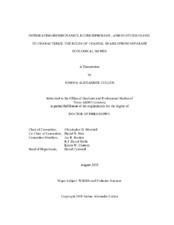| dc.description.abstract | Predators within aquatic environments hold important functional roles that impact the structure and stability of ecosystems. With increasing destabilization caused by climate change, overfishing, habitat degradation, and invasive species, it is critical to comprehensively characterize the functional roles of predators. Sharks are abundant predators in coastal habitats, whose roles can also change over ontogeny. However, the possible mechanisms that drive these shifts in ecological roles have not been directly investigated. This dissertation applies an interdisciplinary approach to discern the ecological roles of bull (Carcharhinus leucas), blacktip (Carcharhinus limbatus), and bonnethead sharks (Sphyrna tiburo) using feeding biomechanics, ecomorphology, and ecotoxicology. Small conspecifics exhibited significant positive allometric scaling of bite force over ontogeny, which was associated with increases in niche breadth and energy-density of prey in bull and bonnethead sharks, respectively. Functional changes in tooth morphology over ontogeny were not found in any of the species, but it appears that the extent of heterodonty may correspond with foraging strategies (generalist versus specialist). The combination of rapid increases in bite force and tooth shape that is bestsuited to primary prey items likely improve prey handling efficiency and increase net energy intake. Chronic exposure of sharks to polycyclic aromatic hydrocarbons (PAHs) within the Galveston Bay, TX likely contributed to similar burdens of this contaminant within all three species. Polychlorinated biphenyls (PCBs) showed a pattern of biomagnification, where high trophic position bull and blacktip sharks accumulated greater burdens than the lower trophic position bonnethead sharks. PCB burdens in these sharks also appeared to accumulate at concentrations above which fish and aquatic mammals experience physiological impacts, suggesting that these species are experiencing deleterious health effects.
Overall, these findings suggest that bull sharks change roles from mesopredators as juveniles to top predators as adults, whereas blacktip and bonnethead sharks remain mesopredators across ontogeny. Differences in habitat and diet also differentially expose all species to certain contaminants, which could be at concentrations that impact shark health in Galveston Bay, TX. | en |


